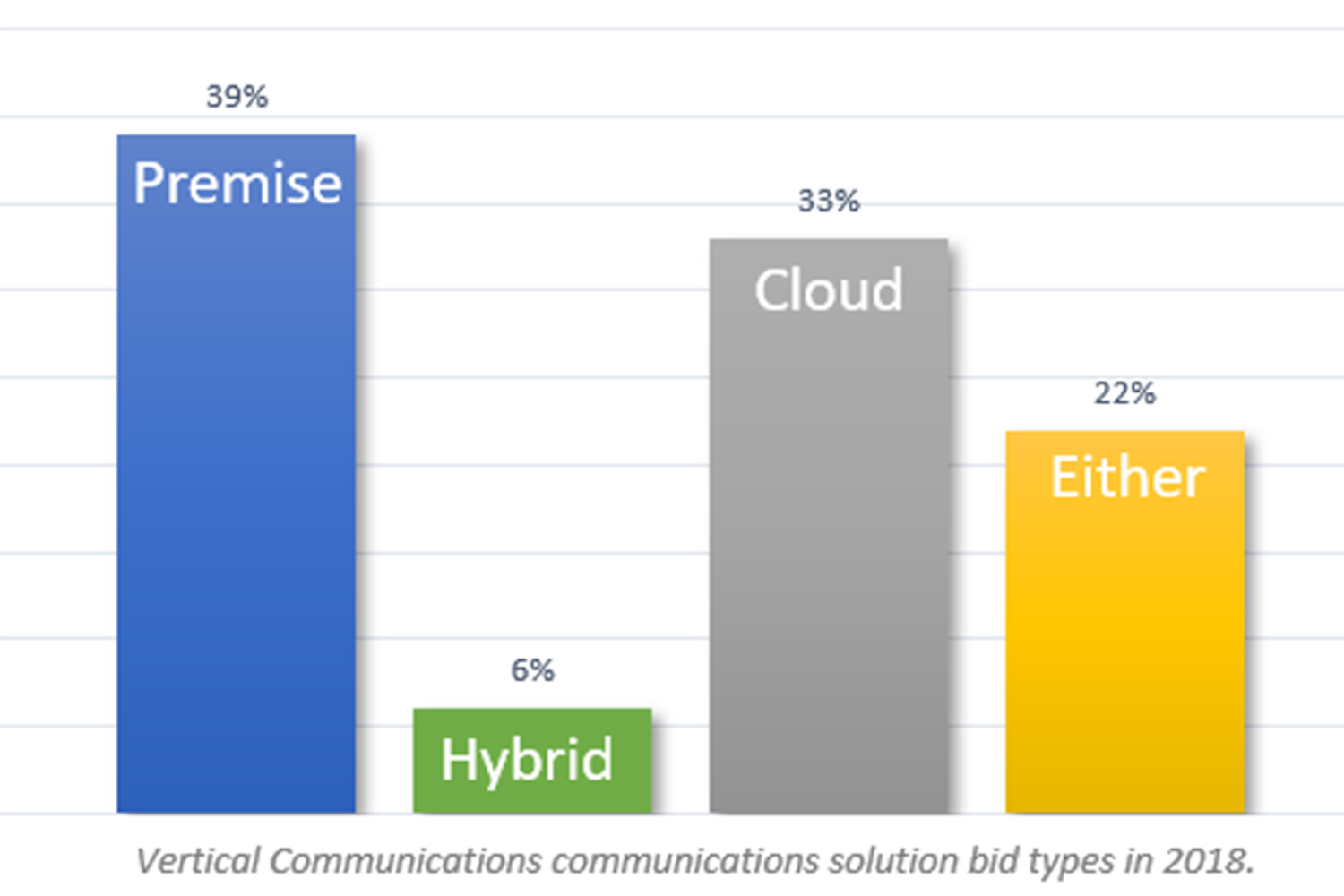Eliminating the Cloud or Premise RFP

Vertical Communications sees an average of 20 bids for communications solutions each month across the country. Our average is to bid on 10-12 of them. Recently, we dived into this data to notice that cloud is beginning to approach premise solutions in requests.
The concerning statistic is the 22% of deals that specify either a cloud or premise solution is acceptable. This trend is problematic as offering an RFP that puts both types of solutions in the mix is detrimental for the consultant, the customer, and the vendors. There are several specific problems with “Either RFPs” to consider.
“Either RFPs” make the bid process too complex
RFPs are already a complex process. The customer must evaluate the price, technology, vendor quality, experience, solution design, and implementation plan all at the same time. This is a key part of the value that consultants bring to the table. The consultant brings experience and expertise to simplify and streamline the process so it can reasonably be done. By adding in the additional complexity of cloud vs. premise solutions, the process is made too complex again. It becomes much harder for everyone involved for two reasons.
First, when offering out a bid that can be cloud or premise, you increase the total possible bidder population. Recently, Vertical participated in a bid that had 55 vendors submitting! I can’t imagine how the decision process is even handled in that case. The influx of IT VARs into the market as well as the rise of the agent model has exploded the number of bidders out in the marketplace. When a bid is open to both cloud and premise, the marketplace for bidders potentially doubles and makes the process harder. Narrowing the pool helps the customer simplify their decision process.
Second, putting in cloud and premise in the same bid forces the customer to make two separate decisions at the same time. The customer must decide if they want cloud or premise AND which vendor. Choices about which delivery model fit the customer become mixed up in the quality of vendor, pricing, and other points. The decision process becomes muddled. These decisions should really be made separately with the delivery model decision made first to lend clarity to the process. Which leads us to the next point.
Helping the customer decide on delivery model is a value-add consultants can provide.
Deciding on which delivery model, cloud or premise, best fits the customer is a service the consultant can include in their process. This decision should be made first before the bid to help eliminate complexity (as already discussed) and clarify the bid.
Deciding on cloud versus premise is generally a financial decision focused around whether the customer wishes to put the communications solution in a OPEX or a CAPEX bucket. There are advantages to each. While there are important advantages to cloud or premise, the financial decision is the overriding factor in our experience.
The consultant can help the customer walk through this decision and make it before putting together the RFP. Here’s one resource on the pros and cons of cloud and premise to use in helping make this decision. Walking your customer through the differences can help them clarify what they really need and separates out one of the biggest decisions from the actual RFP process. You can really show value to your customer this way.
“Either RFPs” put vendors in a tough spot and may cause the customer to lose out.
When Vertical gets an RFP that lists cloud or premise as an option we are immediately stuck making a tough decision. Without knowing the customer’s needs, we have to decide if we want to offer a premise or a cloud solution. We offer both and normally we walk through a consultative process with customers to determine which fits the customer best. However, it’s not possible to do that in an RFP. We have to depend on the consultant to do that work.
It’s possible, on some RFPs, for us to bid both solutions, but that means doubling our workload for the same contract. It’s often not allowed either. So we are stuck trying to discern if the customer really wants cloud or premise.
When we guess wrong, we lose, but the customer can also lose. The customer may not get the best vendor with the best implementation, service, and support. The customer isn’t getting access to the best possible solution, the right vendor offering the right delivery model.
Conclusion
As cloud continues to gain ground in the markets served by consultants, it’s important to consider how to address it in bids. Putting bids out that increase the number of bidders to unmanageable levels and complicates the decision doesn’t seem like the right solution. Forcing vendors to choose a delivery model without enough information about customer needs is not a recipe for the best customer solution. Consultants can really show value by making customers understand this up front and helping them walk through the complexities of choosing the right delivery model. In our opinion, this makes the RFP process easier and more successful for everyone.



